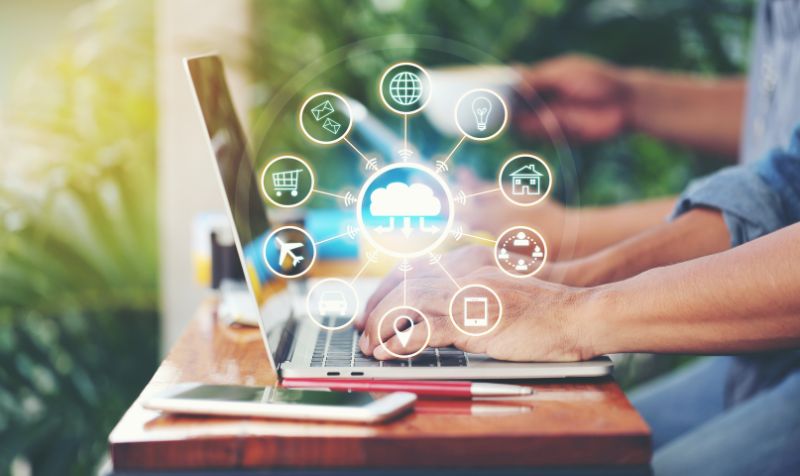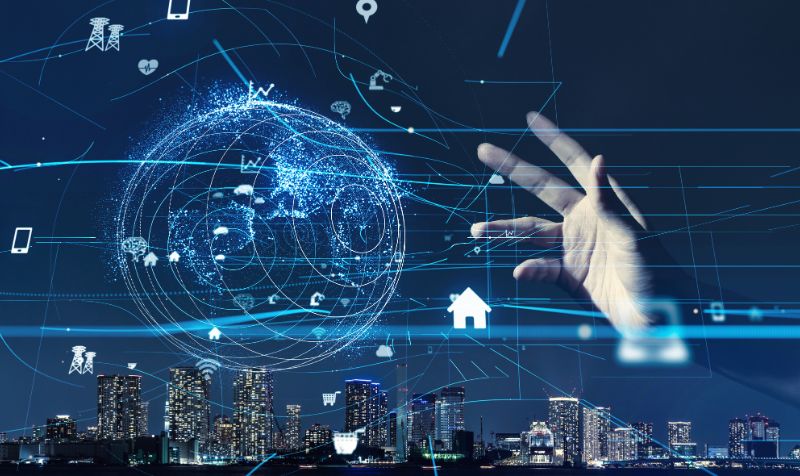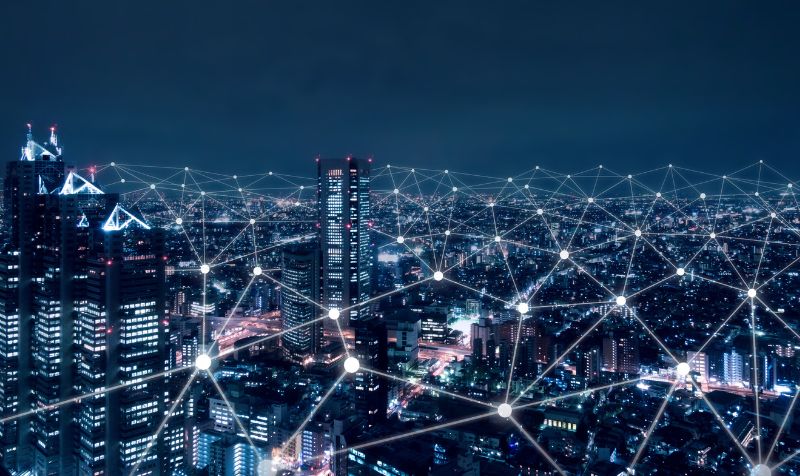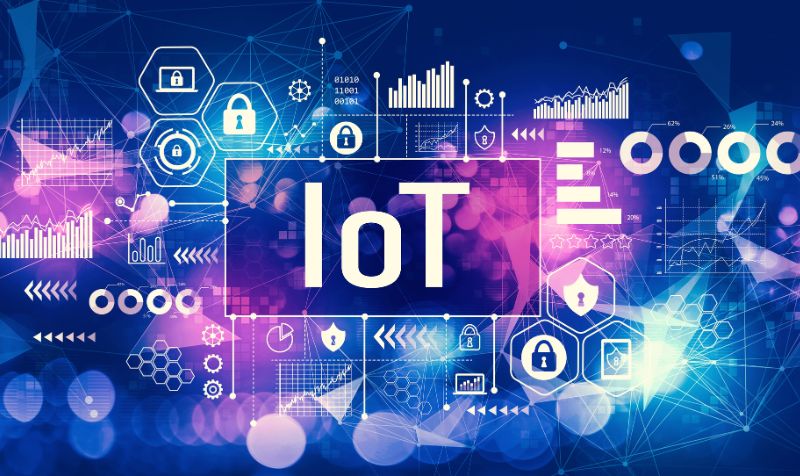- Introduction
The first question that comes to mind is, “What is the full form of IoT?” IoT stands for the Internet of Things, which refers to the network of physical objects embedded with sensors, software, and connectivity to exchange data with other devices and systems over the Internet. The IoT market is experiencing remarkable growth. It is projected to generate US$27.31 billion in revenue by 2023. This indicates the widespread adoption and potential of IoT technologies across various industries.
Among the different sectors, Industrial IoT dominates the market, with a projected market volume of US$9.67 billion in 2023. Industries leverage IoT to optimise processes, improve efficiency, and enhance manufacturing, energy, transportation, and healthcare productivity.
The future of IoT looks promising as well. Revenue is expected to show a significant annual growth rate (CAGR 2023-2028) of 17.05%. By 2028, the IoT market volume is estimated to reach a staggering US$60.01 billion, indicating sustained expansion and opportunities for innovation.
With these impressive numbers, it is evident that IoT is a transformative technology with immense potential. By understanding its fundamental concepts, applications, and components, you can unlock growth opportunities and contribute to the exciting field of IoT.
Now, let’s delve into the various aspects of IoT and equip ourselves with the knowledge to navigate this dynamic landscape.

Welcome to the IoT Revolution: Unleashing the Power of Connected Devices
Let’s look at some interesting facts and trivia about IoT:
- IoT enables the seamless integration of the physical and digital worlds remotely—for example, smart thermostats, wearable fitness trackers, connected cars, and industrial sensors.
- The term “Internet of Things” was coined by Kevin Ashton in 1999 while working at Procter & Gamble. He used it to describe connecting RFID (Radio Frequency Identification) tags to the Internet.
- The first recognised IoT device is believed to be a modified Coca-Cola vending machine at Carnegie Mellon University in the early 1980s. The machine was equipped with sensors and connected to the Internet. It monitored the availability and temperature of the drinks.
Unveiling the Layers of IoT: A Journey through its Architecture
The 7-layer IoT model, also known as the OSI (Open Systems Interconnection) model for IoT, is a conceptual framework that defines the different functional layers in an IoT system. These layers are as follows:
Applications of IoT with an Example

IoT has a wide range of applications across various industries, here are some of the application of IoT with examples:
- Smart homes and home automation
- Healthcare monitoring and remote patient
- Industrial automation and predictive maintenance
- Smart Cities for efficient infrastructure management
- Agriculture for precision farming and crop
- Transportation and logistics eg; Drone delivery
- Energy management
- Retail for personalised customer experiences
One of the fascinating applications of IoT is in the realm of smart homes and home automation. IoT technology has revolutionised how we interact with our living spaces, bringing convenience and efficiency to our daily lives. From smart thermostats that automatically adjust the temperature based on our preferences and behaviour to intelligent lighting systems that adapt to our needs, IoT transforms our houses into interconnected, intuitive environments. With voice-activated assistants like Amazon Echo or Google Home, controlling appliances and devices has never been easier. IoT’s seamless integration into our homes brings comfort, energy savings, and peace of mind, making it a key driver in the future of modern living.
How Connected Devices Collaborate

IoT systems have four main components: sensors/devices, connectivity, data processing, and user interface. Here’s how they interact to function:
- Sensors/devices collect data from the physical environment, transmitted through connectivity technologies.
- Data processing platforms analyse and interpret the collected data, enabling decision-making and triggering appropriate actions.
- The user interface allows users to monitor and control IoT devices, access data, and interact with the system.
- Actuators convert digital signals from IoT systems into physical actions in the real world.
- IoT protocols are rules and standards that enable communication between IoT devices and systems. Common IoT protocols include MQTT, CoAP, HTTP, Zigbee, LoRaWAN, and NB-IoT.
- An IoT gateway acts as a bridge between IoT devices and the cloud or centralised systems. It facilitates device connectivity, data preprocessing, protocol translation, and local analytics. Embedded Linux is an important operating system that is widely used in the gateway devices.
Sensing The Electronic World
IoT Sensors detect and measure physical or environmental conditions such as temperature, humidity, light, motion, etc. These sensors collect real-time data from the physical world. This data is then transmitted to IoT systems for processing and analysis. Sensors are the very foundation of IoT. They enable the monitoring and controlling of various devices and systems.
Potential of Actuators
IoT actuators are devices responsible for taking actions or effecting changes in the physical world based on instructions received from IoT systems. Actuators enable IoT systems to interact with and control the physical environment. Examples of actuators include motors, valves, switches, and relays. They allow IoT systems to trigger specific responses, such as turning on/off a device, adjusting settings, or activating processes.
Building Intelligence
In the architecture of IoT, sensors and actuators play pivotal roles. Sensors capture data from the physical environment, convert it into electrical signals, and transmit it to the IoT network. Various applications and services then process, analyse, and utilise this data. Actuators initiate physical changes in the environment based on commands from the IoT system. Sensors and actuators enable IoT systems to gather data, make intelligent decisions, and remotely control devices or processes.
Transformative Technologies Driving the IoT Ecosystem

There are many technologies related to IoT. Let us look at the prominent ones from those:
What is Narrow Band IoT?
Narrow Band IoT is a low-power, wide-area network (LPWAN) technology. This allows IoT devices to connect to cellular networks efficiently.
What is Industrial IoT?
It refers to using IoT technologies in industrial settings to improve efficiency, productivity, and safety.
What is SDN in IoT?
It refers to applying networking principles defined by software in IoT systems. It allows centralised control, management, and orchestration of network resources in IoT deployments.
What is DNS (Domain Name System) in IoT?
It translates human-readable domain names into their corresponding IP addresses. Thus, it enables IoT devices to connect and communicate with each other over the Internet.
What is MQTT?
It is a lightweight messaging protocol commonly used in IoT. This enables efficient and reliable communication between devices and platforms. It is ideal for low-bandwidth, high-latency, and unreliable network environments.
What is Raspberry Pi in IoT?
It is a popular single-board computer widely used in IoT projects. It provides a low-cost and versatile platform for building IoT prototypes and solutions.
What is Arduino in IoT?
Arduino is an open-source hardware and software platform for IoT prototyping and DIY projects. It offers a range of microcontroller boards and a supportive development environment.
What is Zigbee in IoT?
Zigbee is a wireless communication standard for low-power, short-range IoT applications. It is commonly used for home automation, smart lighting, and sensor networks.
What is M2M in IoT?
M2M refers to direct communication and interaction between machines or devices without human intervention. It is a foundational concept within IoT that enables seamless connectivity and data exchange.
What is Fog Computing in IoT?
Fog computing is a decentralised computing infrastructure. It extends cloud computing capabilities closer to the edge of the network, closer to IoT devices. It enables low-latency data processing, reduced network traffic, and improved privacy and security.
What is SoC (System-on-a-Chip) in IoT?
SoC in IoT refers to a single integrated circuit that incorporates various components of a complete IoT system. This includes processing units, memory, connectivity, and peripherals. SoC devices provide a compact and efficient solution for IoT deployments.
What is the Industrial Internet of Things (IIoT)?
It refers to extending IoT technology, specifically in industrial sectors and manufacturing environments. It involves connecting industrial machines, devices, sensors, and systems to collect and exchange data. This enhances operational efficiency and productivity.
What is a Debugger in IoT?
It is a software tool that aids in identifying and resolving issues or bugs within IoT systems and applications. It allows developers to track and analyse the execution of code and monitor variables and data flows. They can identify errors or unexpected behaviours in IoT devices or software.
What is Bolt IoT?
It is an integrated platform designed to simplify and accelerate the development of IoT applications. It offers data monitoring, real-time notifications, and remote device management.
Gateways to Connectivity
IoT platforms provide a comprehensive infrastructure for managing, monitoring, and analysing data generated by IoT devices on Mobiles application or a web based application. These platforms offer data storage, device management, security, and analytics services. This allows businesses and developers to build and deploy IoT applications. IoT gateways, on the other hand, act as intermediaries between IoT devices and the IoT platform. They enable protocol translation, data filtering, and edge computing capabilities. This ensures smooth communication between devices and the cloud.
Inspiring IoT Projects
IoT projects encompass a wide range of applications across various industries. These projects leverage IoT devices, connectivity, and data analytics to create innovative solutions. Examples include smart cities with intelligent infrastructure, industrial automation for enhanced efficiency, healthcare monitoring systems, agriculture optimisation, and home automation for improved convenience and energy management. IoT projects have the potential to transform industries, improve quality of life, and drive sustainability.
Safeguarding IoT Systems
IoT security is critical due to the vast number of interconnected devices and the sensitive nature of the data. It encompasses measures to protect IoT devices, networks, and data from unauthorised access, tampering, and malicious attacks. IoT security practices include device authentication, encryption, access control, secure communication protocols, and regular software updates to address vulnerabilities.
Building a Successful Career in IoT: Unlocking the Potential
A career in IoT offers tremendous opportunities for growth and innovation in a rapidly evolving field. Here’s a simplified breakdown of four career paths to help you navigate your way to success:
- Complete a Bachelor’s degree (B.Tech) in Electronics and Communication.
- Pursue a Bachelor’s degree (B.E/B.Tech) in Computer Science. Strengthen your expertise with certifications like CIoTS (Certified Internet of Things Specialist).
- Advance further with CIoTP (Certified Internet of Things Professional).
- Take up a specialized IoT Courses
Critical Skills for Success in IoT:
While there are no barriers to you mastering IoT from scratch, developing the following key skills to thrive in the IoT industry can prove crucial:
- Business Intelligence: Understanding the strategic implications of IoT and its impact on business operations.
- Hardware Interfacing: Proficiency in connecting and integrating various hardware components and sensors.
- Data Science: Analyzing and extracting meaningful insights from large volumes of IoT-generated data.
- Machine Learning: Leveraging algorithms and models to enable devices and systems to learn from data and make intelligent decisions.
- Artificial Intelligence: Applying AI techniques to enhance the capabilities of IoT devices and systems.
- Programming Languages: Learning programming languages are the one of the most essential part of learning IoT. Languages like C, C++ and Python are widely used and required languages in IoT.
Career Opportunities in IoT:
A career in IoT opens up a world of exciting job prospects, including:
- IoT Specialist: Designing, developing, and implementing IoT solutions for businesses.
- IoT Architect: Creating and overseeing the architecture and infrastructure of IoT systems.
- Program Manager: Managing IoT projects and ensuring successful execution.
- IoT Consultant: Providing expert guidance and advisory services on IoT implementation.
- IoT Developer: Building software applications and firmware for IoT devices.
- Industrial Data Scientist: Analyzing and interpreting data to optimise industrial processes.
- IoT Product Manager: Overseeing the development and launch of IoT products.
Salary and Demand in IoT:
The demand for skilled IoT professionals is high, with excellent salary prospects. As a fresher, you can expect an average salary of over five lakhs annually. The pay may go up to 10-25 LPA for mid-level professionals. IoT is a fast-developing industry, and the demand for IoT engineers is expected to rise. If you have the aptitude and interest to pursue IoT, sign up for courses to prepare yourself.
Conclusion
We have comprehensively covered IoT and the industry, from its definition and applications to its components and protocols. Whether you’re intrigued by IoT’s potential or looking to advance your career in this field, the knowledge you’ve acquired will serve as a solid foundation. Embrace the endless possibilities of IoT and continue your learning journey to unlock its full potential. Explore our wide range of IoT courses and resources on our portal. Discover more IoT courses here.
FAQs
- What is the history of IoT?
IoT had its roots in the early 1980s when the idea of connecting devices and enabling machine-to-machine communication emerged. Advancements in wireless technology, sensors, and data analytics have accelerated the growth of IoT.
2. Who is the father of IoT
Kevin Ashton is considered the “father of IoT” for coining the term “Internet of Things” while working at Procter & Gamble in 1999. He envisioned a world where everyday objects could connect and communicate through the Internet.
3. Who created the first IoT device?
The first IoT-like device, the Trojan Room coffee pot, was created by Quentin Stafford-Fraser and Paul Jardetzky at the University of Cambridge in 1991. It became a symbol of early IoT innovation by allowing remote monitoring of the coffee pot using the Internet.
4. What is IoT? What is the main principle of IoT?
IoT (Internet of Things) refers to the network of physical devices embedded with sensors, software, and connectivity. Its main principle is connecting physical objects to the Internet and enabling them to collect, exchange, and analyse data. This interconnectedness and data sharing facilitates automation, real-time monitoring, and intelligent decision-making.
5. What are the advantages of IoT?
IoT offers numerous advantages, including improved efficiency and productivity. They enhance decision-making through real-time data insights, process automation, cost savings, remote monitoring and control. They also provide predictive maintenance and the ability to create new innovative services and business models.
6. What are the disadvantages of IoT?
Disadvantages of IoT include potential security vulnerabilities, privacy concerns due to increased data collection, and the risk of system failures or disruptions impacting critical operations.
7. What is IoT used for, and how is it used?
IoT is used in various applications, including smart homes, healthcare monitoring, industrial automation, agriculture, transportation, and environmental monitoring.
8. How do IoT devices function?
IoT devices function by collecting data from their surroundings using built-in sensors. They process and analyse this data either on the device or in the cloud. They then communicate the results to other devices or systems.
9. What are examples of IoT?
Examples of IoT include smart thermostats, wearable fitness trackers, connected home security systems, industrial sensors for monitoring equipment, intelligent agriculture systems, and connected cars.
10. What are the four types of IoT?
The four types of IoT are consumer IoT (intelligent home devices, wearables), commercial IoT (industry-specific applications like asset tracking), industrial IoT (machine monitoring, predictive maintenance), and infrastructure IoT (smart cities, intelligent transportation systems)




Leave a Reply